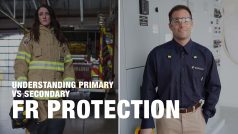
Safety managers have a very important decision to make when determining the type of personal protective equipment (PPE) that their team needs. Before nailing down the fabric, apparel and PPE brands they would like to select, they first need to determine whether their team, or even specific members of their team, require primary or secondary FR protection to help perform their job responsibilities as safely as possible.
There are big differences in the levels of primary and secondary protection, so let’s first define what each means.
- Primary PPE is designed for protection against an existing known hazard or for interacting with said hazard, or when a significant risk is present. Primary PPE examples, which is usually task-based gear, include aluminized suits, firefighter turn out gear, safety glasses, hard hats, face shields, aprons, hearing protection and gloves.
- Secondary PPE is designed for continuous wear throughout one’s workday for protection against potential intermittent, short-term thermal exposures, like arc flash, flash fire, intermittent molten metal splash and welding slag. Secondary PPE examples include FR pants, shirts, coveralls and balaclavas.
Understanding the task at hand and the risk and severity of hazard exposure are integral to determining whether secondary AR/FR protection is adequate or if primary protection is required.
Let’s review the key differences in primary versus secondary AR/FR PPE protection.
- Primary protection is typically used for a certain task for a limited amount of time when there is an increased likelihood there will be a thermal exposure. Firefighting is a prime example. Primary PPE may also be needed if there is a potential exposure task posing a greater, or more severe, thermal event.
- Primary FR protection can’t be worn for long due to heat stress concerns. Primary FR protection is typically constructed with fabrics that do not breathe well and often involves multiple layers, so frequent breaks are needed to allow your body to cool down.
- Secondary FR protection is designed for continuous wear in situations where short-term, intermittent thermal exposures are possible, like working on electrical equipment. The key difference is that an exposure might occur, so you must prepare yourselves accordingly to decrease the severity of injury.
Some tasks are not always clear cut, however. Work involving molten metal, for example, can be challenging to determine which PPE (primary or secondary) is appropriate for the hazard.
In tricky situations, consider the exposure severity in a certain task – for example, how much molten metal will the flame-resistant fabric of the PPE shed during the worker’s task, and could this molten metal exposure overwhelm the protective fabric system and cause burn injury. For tasks involving light welding where there is not much of a risk or severity of exposure, secondary FR protection could be an option, while molten metal exposure during a pouring task would likely require primary FR protection. Three key things to consider—the likelihood of exposure occurrence, the ability of the FR fabric to shed the molten metal and potential amount of molten metal exposure—will help determine which PPE type could be worn for that task and in that environment.
The most important factor in determining whether a team requires primary or secondary FR protection is that the decision is based on a thorough risk assessment conducted by qualified safety managers and engineers at the location in question.
No matter the task at hand, an organization’s safety personnel must create a safe working environment by utilizing the various risk control methods to reduce the likelihood of thermal incident occurrence, and mitigate, by accounting for proper PPE use, should an incident occur.
